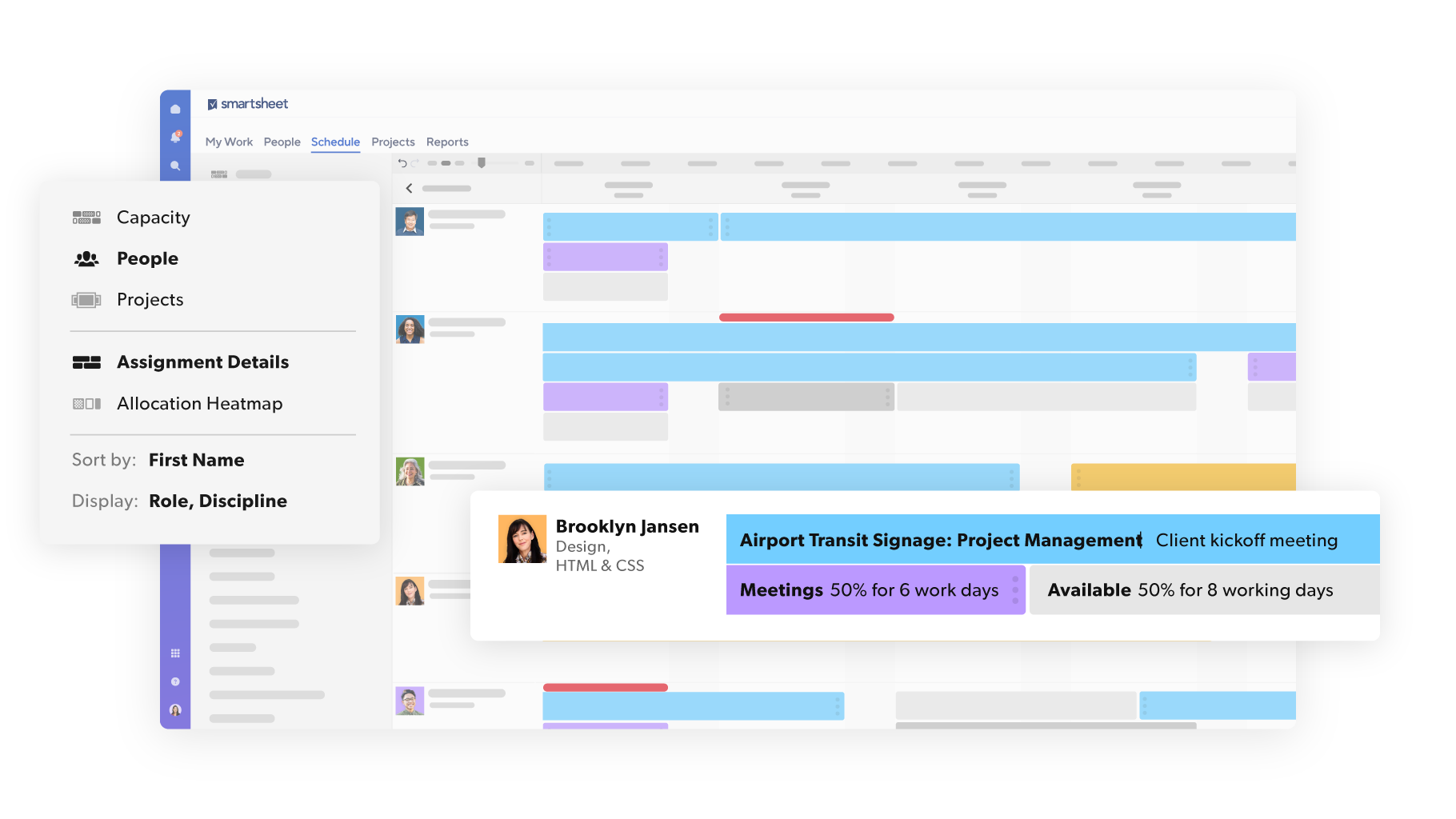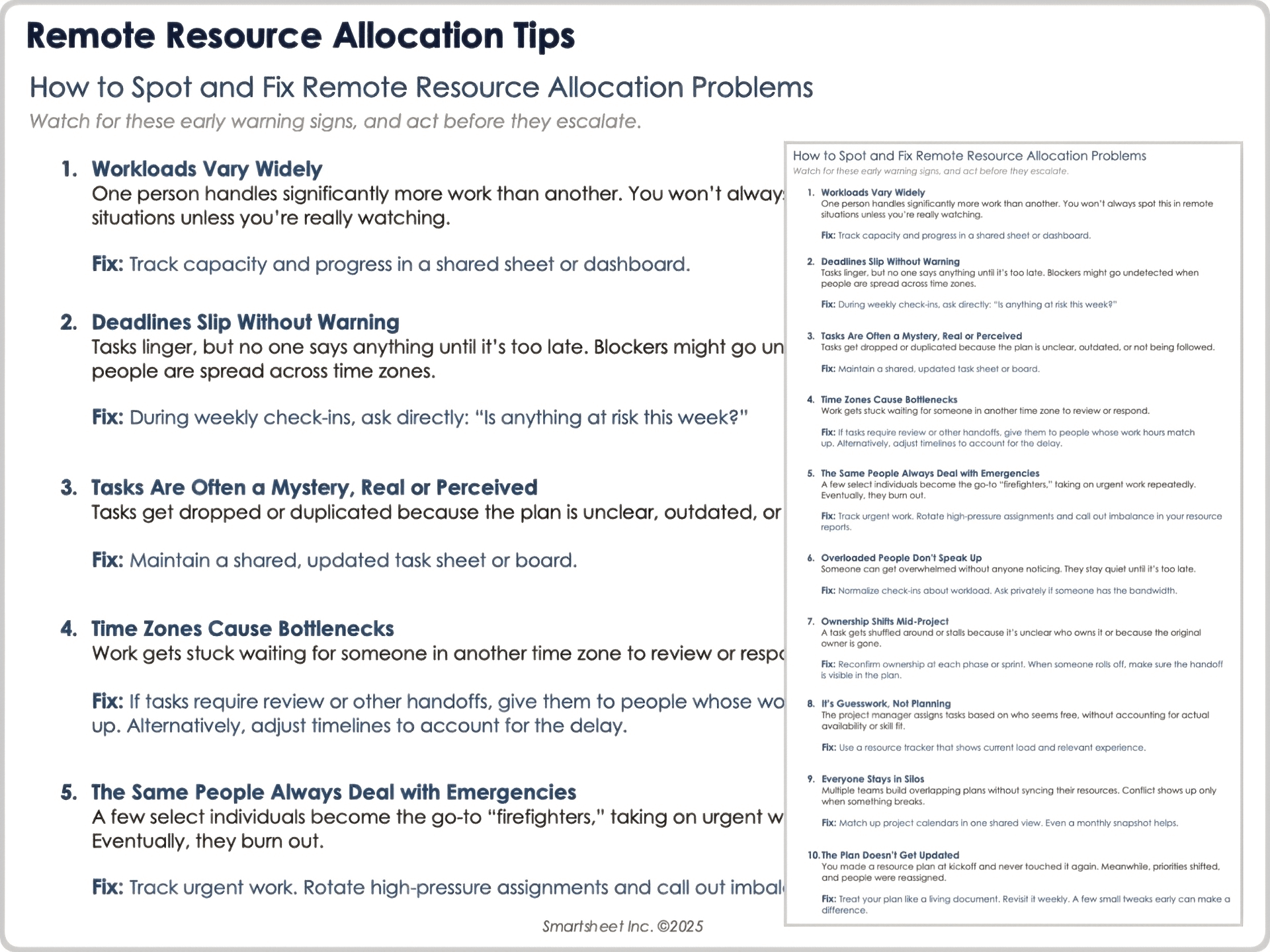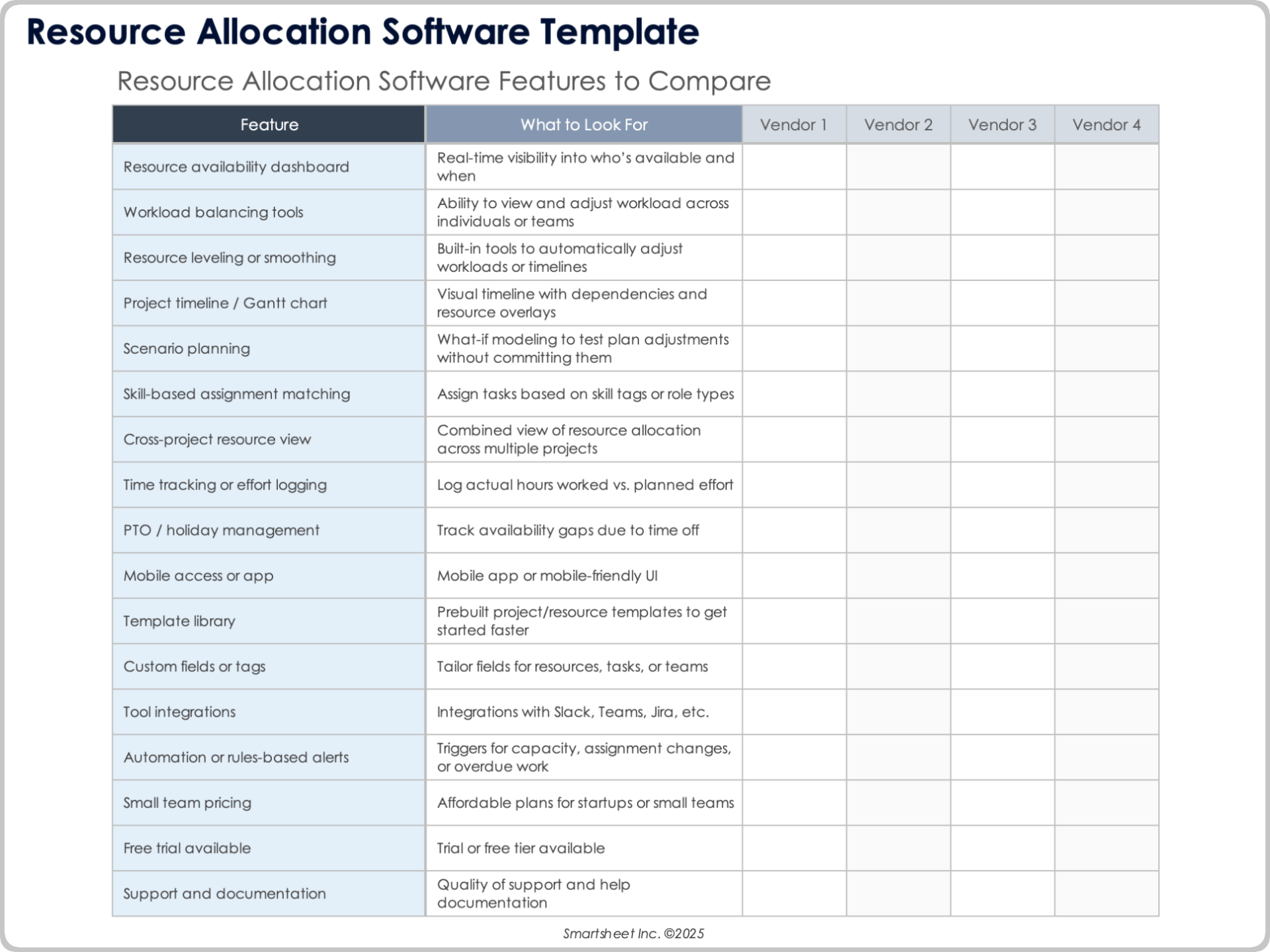What Is Resource Allocation?
Resource allocation is the practice of assigning the right people, time, budget, and tools to get work done, at the project outset and as priorities shift. Good allocation turns strategy into execution; poor allocation leads to delays, budget overruns, or burnout.
Most projects draw from a mix of these resource types:
- Budget: How much funding is available for labor, software, contractors, and materials?
- Materials: What supplies or parts are required, especially for production-heavy work?
- People: Who is available to do the work, and do they have the right skills and capacity?
- Tech Infrastructure: What servers, systems, or networks are necessary to support the project?
- Time: How long will each task actually take?
- Tools and Equipment: What digital or physical assets are needed to complete the work?
Whether you’re creating an app or pouring concrete, the questions are the same: What do we have, and how do we use it most effectively?
What Is Resource Allocation in Project Management?
A large portion of project management comes down to effective resource allocation. Matching the right people, tools, and time to the work helps keep projects on track and costs under control. Even strong strategies can fail without clear, real-time decisions about how resources are used.
A 2018 study published in the Journal of Industrial Engineering International found that mismanaged resource allocation was one of the biggest reasons projects went over budget and missed deadlines. When project managers employed a more structured, scenario-based approach, they dramatically improved both timelines and costs — in some cases, cutting project lengths by weeks and total spend by nearly half.
Resource management plays such a critical role that larger companies typically hire dedicated project managers to handle it. In smaller businesses, someone else might take the lead — but they should understand the basics well enough to lay out a plan that works not only in theory, but also in practice.

Figuring out what will work in practice, however, can be a challenge. “Resource allocation is more of an art than a science,” says Lulu Richter, Senior Project Manager at Smartsheet. “Unless you're working in a highly predictive field, there will be ambiguity, delays, and disruptions.”
Fortunately, teams can use proven methods and tools to manage that uncertainty and allocate resources more effectively.
Build the right team for every project

Resource Management by Smartsheet helps you align skills, availability, and capacity to deliver better results—without burnout. Get a clear view of who’s available, what they’re working on, and how to staff projects with confidence.
Methods Used for Resource Allocation
Project managers employ different resource allocation methods based on a company’s goals, a project’s intention, and a team’s size and skill distribution. They might use the critical path method to safeguard deadlines, resource leveling to avoid team burnout, or flexible heuristic rules to assign tasks efficiently.
Resource allocation methods generally fall into four categories: timeline control, workload balancing, simplified rules, and strategic prioritization.
Here is a closer look at these categories, along with common methods that fall under each:
Timeline-Focused Methods
These approaches focus on meeting deadlines while accounting for on-the-ground realities.
- Critical Path Method (CPM): Ideal for deadline-sensitive projects, CPM identifies the lengthiest chain of interdependent tasks, known as the critical path. Tasks on the critical path take top priority because any delays in them will delay the whole project. Learn more about this proven technique in our guide to the critical path method.
- Critical Chain Method (CCM): Building on CPM, CCM adds time buffers to protect against delays, especially when key resources are shared across tasks. It’s commonly used in manufacturing or engineering projects that require tight sequencing and resource coordination. Find expert tips and tools to help you get started in this article on the critical chain method.
Workload-Balancing Methods
These methods allow you to reassign tasks or timelines to avoid overallocation.
- Resource Leveling: Leveling involves adjusting the project timeline so that you don’t overload an individual. For example, when two critical items need the same person at the same time, you might push one task to a later date. While this helps balance workloads, it often extends the project’s duration.
- Resource Smoothing: With this approach, project managers keep the original deadline fixed and reallocate resources only where there is available slack (also called float). This method is useful when you can’t afford to miss the final delivery date but want to reduce workload spikes along the way. In some cases, it’s a more adaptable alternative to leveling.
These techniques are especially useful for project managers who are juggling shared resources or limited bandwidth. You can learn more about how to apply them in this guide to resource scheduling, loading, and leveling.
Simplified or Manual Approaches
These simple techniques are easy to implement but have drawbacks, especially as complexity increases.
- Heuristics: Heuristics are simply basic rules of thumb. When using this method, project managers might assign tasks to the first available qualified person or split up work equally among team members. These rules can be sufficient for small businesses or short projects, but they tend to break down in more complex or layered environments.
- Manual Scheduling (Gut + Spreadsheet): Still common in many businesses, this loose approach relies on the project manager’s judgment, informal team input, and spreadsheets. It can work well on a small scale, but quickly becomes difficult to manage without visibility into everyone’s availability, especially when multiple projects or departments are involved.
Strategic Allocation Approaches
These methods rely on strategic judgment to match resources to work.
- Priority-Based Allocation: With this method, project managers assign people and tools to the most critical, high-impact tasks first. It’s especially helpful when demand exceeds capacity and trade-offs are inevitable.
- Cost-Benefit Allocation: When using this method, teams weigh each task’s expected value against its resource demands, prioritizing those that offer the greatest return. This method is common in product development or when managing competing business goals.
Which Resource Allocation Method Do Project Managers Commonly Use?
Project managers commonly use a mix of resource allocation methods, including critical path, resource leveling, and priority-based approaches. The choice depends on the industry, project type, team capacity, and timeline flexibility. Most managers shift between formal methods and strategic decision-making based on real-world constraints.
In construction, engineering, manufacturing, and government projects, project managers often lean on critical path or critical chain methods. These sectors usually require precise sequencing, fixed budgets, and firm delivery dates, so planning around task dependencies and buffers is critical.
In contrast, project managers in software, creative, consulting, nonprofit, or marketing environments tend to work with more fluid timelines and overlapping priorities. In these fast-paced settings, they are more likely to use resource leveling or value-driven approaches such as priority-based or cost-benefit allocation. These methods help teams stay focused on what matters most when they can’t do it all.
“I prefer a combination of priority-based or cost-benefit resource allocation,” says Richter, who manages technical projects at Smartsheet. “Generally, most teams are given more work than they can reasonably accomplish, and evaluating your projects and tasks for impact and priority gives you some sense of where that cut-off line exists. Once I know that my highest-impact tasks are fully supported, I can fill in the gaps with less critical or timely work.”
In practice, most project managers adapt as conditions shift. A well-structured plan might guide the start, but real-world constraints — such as delays, shifting priorities, and capacity limits — often call for course corrections and judgment calls. Knowing when to switch methods is a key part of strong project leadership.
How to Create a Resource Allocation Plan
Resource planning starts before a single task is assigned. First, understand what’s required: what the work involves, who’s available, and which limitations matter most. It’s not about wishful scheduling — it’s about building a plan that can successfully flex and play out in the real world.

“When I create a resource allocation plan, I look at constraints, not availability,” says Jamilyn Trainor, Senior Project Manager at Müller Expo Services. “Realities are shaped by space, budget, and resource bottlenecks. If I can figure that out early in the process, I avoid overpromising and underdelivering.”
By starting with limitations, you help avoid blind spots from the outset. Here are eight steps to create a flexible plan that won’t implode when you face adversity:
1. List Every Task Within Scope
Open a spreadsheet, Smartsheet, or your project management tool of choice. Create a table or board where you can list every single task. You’ll have one row or card per task.
If you have a project scope document, that’s a perfect starting point. Talk it through with your team. Don’t worry about who will do what in this step. That comes later. Your goal here is to capture all the tasks in one easily updatable place.
Don’t merely include milestones, such as launch campaign or submit final report. Break those into specific tasks, such as draft outline, get stakeholder feedback, or upload final version to platform.

“I always start with the big picture: what exactly needs to get done and by when,” says Mikko Pasanen, founder of Miko LLC, a general contractor managing residential, commercial, and government infrastructure projects. “Once I understand the scope and timeline, I can figure out who I need, what equipment we’ll use, and how to time everything so crews aren’t stepping on each other’s toes.”
2. Estimate Time Needed
For each task on your sheet or project board, add a time estimate. Focus not on the number of days it will take, but the hands-on hours someone will need to complete the task. These estimates help you figure out what’s reasonable in a given week and whether your overall timeline makes sense.
“I first decide how the team will estimate their efforts, and if I am expecting a high or low level of accuracy in those estimates,” says Richter of Smartsheet. “Accurate resource allocation can be time-consuming to support, so you want to determine the actual needs of your organization before you start planning every resource’s capacity down to the minute.”
3. Identify Skill Needs
For every task on your sheet or board, ask: What type of skill does this actually require? Is it copywriting, UX design, data entry, or server setup? Be as specific as you can.

“We maintain a real-time digital skills matrix for each of our technicians, detailing certifications and proficiency in various systems,” says Jason Rowe, Director and Founder of Hello Electrical. “If an urgent job comes in, we don’t just check who’s free — we look at who has the exact qualifications and bandwidth. That alignment saves time and avoids rework.”
4. Map Out Task Dependencies
Before you start assigning work, circle the tasks that have a predecessor. Does one depend on completing another? If so, make that clear in your sheet or project tool. Mapping dependencies isn’t only about sequencing; it’s about protecting the entire plan from cascading delays.
“Managing dependencies is a major challenge in resource management, especially if you are working with resources that are allocated to multiple projects simultaneously,” Richter says. “My goal as a project manager is to develop an execution plan that utilizes the full capacity of each resource, but one missed deadline very easily has the ability to derail that ‘perfect’ plan. Providing the appropriate space in your allocation plan to absorb unexpected delays can help prevent an endless cycle of replotting and planning.”

Alex Smith, Co-Owner and Manager at Render3DQuick.com, a fast-paced architectural visualization studio, stresses the importance of sequencing. “What I always do is look initially at the identification and sequencing of critical project dependencies,” he says. “3D artists need to wait until CAD specialists complete client drawings, and there may be three to five days with revisions. Careful planning averts knock-on delays that can cause a project schedule to extend by weeks.”
5. Build Your Resource List With Real Availability
Now it’s time to list your people and tools. Figure out how much time they can give — after you account for other work, time for meetings, or time off. If someone’s involved in another project, maybe you only get 30 percent of their week. That’s not a problem as long as you plan for it.
Don’t forget shared resources, such as lab space, staging servers, or specialized gear. These need to be scheduled, too.

George Chasiotis, Co-Founder of the digital consultancy Restartt, learned that availability isn’t the same as readiness, especially when humans are involved.
“One time, we gave a big task to someone who technically had time, but they were mentally drained from another project,” he says. “On paper, it made sense. In reality, it backfired. The work dragged, and they were overwhelmed. That taught me to not just check calendars, but to ask people how they’re feeling. A five-minute check-in can save you a lot of time later.”
6. Assign the Work
It’s time to match people to tasks. Using all your prep work, go one by one and assign each task to someone with the right skills and availability. Use your spreadsheet or tracker to log who’s doing what, when they’ll do it, and how long it should take.

Jeff Kaiden, CEO of the logistics firm Capacity, explains his holistic allocation process: “Once the priorities are nailed down, I map them to the trucks, people, and warehouse space that actually exist on the ground. Until that picture is sharp, any schedule or resource chart is a guess dressed up as a plan. If you are allocating resources for the first time, look past the obvious task list. Spend time getting to know the people available, their strong suits, and the real reason each task exists. When schedules collide, you will need to make trade-offs, and understanding the strategic ‘why’ makes the call easier.”
This combination of hard logistics and human awareness keeps your assignments grounded. You don’t need fancy software. You can color-code your sheet, but make sure the big picture adds up.
7. Review the Plan and Look for Conflicts
Once you make your assignments, take a step back. Is anyone booked too heavily? Are any items still floating with no owner? Do two people need the same piece of gear at the same time?

Justin Wheeler, CEO of the nonprofit fundraising platform Funraise, says visual workload tools make a huge difference for his team. “Seeing everyone’s bandwidth visually has helped us avoid overloading top performers,” he says. “It makes it so much easier to spot bottlenecks before they become issues.”
Even if you’re not using software, review the plan with your team and adjust. It’s always better to catch a snag early than to scramble midproject.
8. Keep the Plan Up to Date
Plans change — a shipment gets delayed, a task takes longer than expected, a key person calls out sick. Your plan needs to stay flexible.
Schedule a weekly team meeting to assess the plan. Identify where you’re falling behind and who might be overloaded, and update your plan accordingly.
Which Smartsheet Template Works Best for Resources?
You can use the Smartsheet project and resource management template set to assign tasks, track who’s doing what, and monitor overall project progress, all in one place. Small to midsized teams that want a straightforward template can use it to manage work and capacity without having to build their own.
The simple project and resource management template set includes a combination of sheets, reports, and a dashboard. They work in unison to give you real-time visibility into task status, team assignments, and upcoming workload. You can customize any of them to fit your project structure, or use them as is to get up and running quickly.
All reports and dashboards are already wired to the source sheets, so they’ll update automatically as your project progresses.
Here’s what’s included in the template set:
- Task Tracker: This is your central list of project tasks. It includes columns for task names, due dates, owners, and statuses. You can also add custom fields, such as Priority or Effort Estimate, to support your planning.
- Upcoming and Past Due Tasks Report: This report pulls from your task tracker and highlights anything that is overdue or has an approaching deadline. It gives you a filtered view so that you don’t have to scroll through the full list. You can use this to drive weekly standups or check-in meetings.
- Open Task Allocation Summary: This report shows how tasks are distributed across your team. It helps you spot when someone has too much — or not enough — on their plate. You can use it to make sure workloads are balanced and reassign work before milestones go off track.
- Project and Resource Overview Dashboard: This dashboard pulls data from all sheets and reports into a single view. It shows overall project status, individual workloads, and progress toward deadlines. You can customize the dashboard widgets to show charts, counts, or task summaries based on what’s most useful for your team or stakeholders.
Benefits of Resource Allocation
Effective resource allocation ensures the right people, tools, and time are matched to the right tasks. It helps projects stay on schedule, within budget, and in alignment with priorities, while avoiding overload and confusion. Done well, it creates clarity, balance, and room to adjust when your work shifts.
That’s true whether you’re managing an Agile development cycle, optimizing resources across departments, or using productivity software, task management tools, or workforce management systems to track the work. A strong allocation plan also supports tighter team collaboration and smarter capacity planning, which you can learn more about in this all-in-one guide to capacity planning.
Here are the benefits of optimizing resource allocation:
- Keeps Deadlines Realistic: You’re more likely to hit key dates when the right people take on the right tasks — and when they don’t have too much to juggle at once.
- Spots Problems Early: With a clear view of who’s doing what and when, you can see right away if someone’s overloaded, if tasks are unclaimed, or if multiple teams need the same resource at the same time. This helps you avoid burnout, prevent costly downtime, stay on budget, and adjust before issues escalate.
- Clarifies Who’s Doing What: When everyone sees their name next to a task, there’s less confusion about ownership and you miss fewer details.
- Makes the Most of What You Have: Whether you’re short on time, tools, or people, your plan helps stretch resources without burning out the team.
- Makes It Easier to Adjust on the Fly: When things change — and they will — you already know what’s flexible and what’s not. That makes it easier to shift items around while keeping pace.
- Gives People Confidence in the Plan: When you map out details clearly, people are more likely to trust the process and commit to the work.
Resource Allocation Examples in Project Management
Examples of resource allocation can come from any industry that uses project management. In marketing, it might mean bringing in a freelancer when the design team is overloaded. In construction, it could involve spacing out tasks so that two crews don’t need the same equipment at once.
Project managers everywhere face resource issues, but it’s how they respond that makes all the difference. Here are everyday scenarios of good resource allocation playing out in different industries:
- Marketing Campaign With a Stretched Design Team: A marketing team is gearing up for a product launch, but their lead designer is already slammed. Instead of forcing it, the project manager moves design-heavy tasks to the start of the schedule and brings in a freelancer to cover the lighter stuff. That gives the core team some breathing room and keeps the launch timeline intact.
- Construction Project With One Piece of Equipment: On a job site, two tasks — grading and concrete work — need the same excavator. The project manager notices it before it becomes a problem and spaces out the tasks by a couple of days. Renting another machine would cost too much, and this simple shift keeps the schedule and budget on track.
- Dev Sprint With Overlapping Assignments: A software team starts a sprint with two big features, both needing front-end work. But only one front-end developer is available. The project manager moves one feature to the next sprint and brings in QA early to work on what’s already done. It’s a small adjustment, but it keeps plans moving without burning out anyone.
- Nonprofit Event With One Person Doing Three Jobs: At a small nonprofit, one person is handling venue logistics, speaker invites, and promotion for a big conference. It’s too much. The project lead assigns speaker outreach to one teammate and marketing to another. Now everyone has a clear focus, and the event doesn’t fall behind.
- Flu Shot Clinic With Overbooked Staff: At a community clinic, nurses are scheduled to give vaccines and see patients at the same time. That’s not going to work. The clinic manager bumps a few routine appointments to the next day and brings in a part-time nurse to help with shots.
- Creative Agency Juggling a Rush Job: A top client needs a rebrand — fast. The account manager pauses internal work and reassigns two designers from a less prominent client. Because they adjust early, the rebrand goes out on time, and nobody has to scramble at the last minute.
- Aged Care Staffing With Demand-Driven Allocation: At EnableU, an aged care and disability services provider, Managing Director Conrad Wang uses a demand-driven model to keep costs lean. “We follow a just-in-time compute method for resource allocation, which allows us to align staffing, technology, and compliance workflows to actual demand, rather than blanket overstaffing or overbuying tech capacity just in case,” he says. “This approach has helped us reduce idle staffing costs by 18 percent while maintaining service quality.”
Challenges of Resource Allocation and How to Solve Them
Resource allocation challenges include unclear capacity, overallocation, and shifting priorities. To address these issues, choose tools that provide visibility into workload and skills, not just availability. Build in flexibility and buffers, coordinate across projects, and proactively flag risks. Teams can also stay adaptable with cross-training and clear communication.
Challenge: Seeing Capacity Limits
Without the right tools, you might not know who’s available or what they can handle. You might think someone is free based on the calendar, but that doesn’t mean they have the right skills for the work.
What Helps: Use a shared view of the project, even if it’s a basic workload tracker. Ask your team leads to review it weekly. If your platform has a capacity dashboard, make it part of your status meeting prep.
One project led by Rowe at Hello Electrical illustrates this kind of blind spot. His team assigned four senior technicians to a smart home integration project, assuming their general experience would be enough.
“This was a hidden skills gap, not a shortage of people or time,” Rowe says. “We had four experienced technicians scheduled for a complex smart home integration, but 10 days in, we discovered none of them knew the European system’s programming. We immediately reallocated two senior technicians and brought in an external consultant with specialized knowledge for one week, at an unexpected cost of $5,000. We then cross-trained our team. This midproject reallocation prevented a much larger problem of delays, client dissatisfaction, and rework costs that could have exceeded $20,000.”
This experience shows why visibility needs to go beyond availability. You also need insight into capabilities and coverage gaps.
Challenge: Overallocation and Resulting Burnout
When timelines are tight, it’s tempting to keep stacking tasks on your best people, but that’s how projects drift into overtime and teams burn out.
What Helps: Watch for anyone consistently booked over 85–90 percent of their time. Spread out high-effort tasks, stagger deadlines, and flag load issues early. If someone’s always carrying extra weight, adjust the plan.
Creative professionals especially need breathing room to do their best work. Savvy allocation builds in that space before burnout hits.
Challenge: Unclear Priorities or Shifting Demands
Projects rarely stay static. A sudden change in scope or new stakeholder request can throw off your allocation plan.
What Helps: Add time and resource buffers when possible, and keep your plan flexible enough to reallocate without starting over. Establish a process for evaluating change requests, and make sure your team knows how to raise red flags when priorities start to shift.
Challenge: Competing Projects
If your team works across multiple initiatives, they’re probably feeling competing pressures. Without coordination, that creates hidden overload and scheduling chaos.
What Helps: Use a master calendar or cross-project view to spot conflicts. Align deadlines where possible. Be clear about what work is fixed and what’s flexible.
Challenge: Last-Minute Changes
People get sick. Vendors drop out. A tool stops working right when you need it. If your plan works in only ideal conditions, you’ll constantly be in recovery mode.
What Helps: Don’t rely on one person or resource to carry a critical task unless you have a fallback plan. Cross-training can help.

“Don’t just focus on efficiency; focus on adaptability,” says Jacky Chow, COO and Project Director at FastPreci, a precision parts manufacturer. “Projects rarely go as planned, so it’s not just about perfect allocation — it’s about being ready to pivot without breaking momentum.”
Agile planning isn’t a luxury — it’s a survival strategy. When you build flexible systems and mentalities, last-minute changes become manageable, not catastrophic.
Challenge: Remote Teams
When people aren’t in the same location or even the same time zone, resource planning gets harder. Miscommunication, duplicate work, or handoff delays can stymie progress.
What Helps: Make your resource plan visible and easy to access. Document who owns what. Account for overlapping time zones when assigning collaborative tasks. Use weekly check-ins to help surface blockers before they get buried.
Free Tip Sheet for Remote Resource Allocation

Download the Remote Resource Allocation Tips for Adobe PDF
Project managers can use this tip sheet to find and fix resource allocation snags in remote teams.
How Software Helps With Resource Allocation
Resource software gives project managers a live window into workload, capacity, and conflicts. These tools — often part of broader workforce management, capacity planning, or task management systems — help teams make smarter decisions about who does what and when, reducing guesswork, overbooking, and idle time.

For Tomas Melian, SVP of Marketing at DiabetesTeam, the ability to match staffing and infrastructure to real demand has been essential.
“The first step we take is mapping demand versus supply with predictive auto scaling so that resources match actual workloads, not wishful estimates,” he says. “We use real engagement data to figure out where to put people, budget, and tools. This stops us from overprovisioning during slow periods, while making sure we're ready for busy periods.”
This kind of data-backed flexibility is what separates spreadsheet juggling from true resource planning. Software makes it easier to do all of the following:
- Spot overbooked team members before burnout sets in.
- Identify unassigned tasks and fill gaps early.
- Reallocate work in real time when conditions change.
- Coordinate across multiple projects.
Software also helps you enforce structure, standardizing how effort, skills, and availability are tracked across the team.
The ROI of Using Resource Management Software
Spreadsheets can work for a while, but as teams grow or projects become more complicated, time spent tracking details can drag down productivity.
Here’s where software can help:
- Fewer Delays and Last-Minute Changes: When you can see conflicts early, you can fix them early.
- Greater Team Utilization: Resource planning tools match people’s skills and availability to the right tasks, so team members can stay productive without becoming overbooked.
- Faster Response to Changes: When priorities shift or new work appears, software can help you reassign tasks, update timelines, and notify team members.
- Better Forecasting: Once you track time, cost, and resource usage over several projects, you can use that historical data to budget and plan with more confidence.
Even lightweight platforms can deliver a strong return, especially if they reduce project slippage, improve handoffs, or prevent rework due to overload.
Free Matrix to Compare Resource Allocation Software

Download the Resource Allocation Software Template for Excel
Use the resource allocation software matrix to compare vendors against key features.
How Smartsheet Helps With Resource Allocation
If you’re comparing resource planning tools, Smartsheet offers both flexibility and depth, from ready-made templates to more advanced solutions. For teams managing multiple projects, shifting timelines, or distributed resources, Resource Management by Smartsheet delivers the visibility and control needed to make confident allocation decisions in real time.
“I’ve used a variety of different resource allocation tools, and Resource Management by Smartsheet has been the most flexible tool I’ve used,” says Smartsheet’s Richter. “It connects directly to my project plans, and I have the ability to select which tasks I would like synced to my allocation plan. I have multiple views that support reporting on the individual, team, or function level, and data can be changed either directly in Resource Management or my project plan.”
Not all tools offer this flexibility. “Using other tools, I have had to adapt my workflows significantly to support resource allocation — and sometimes was required to duplicate entries and efforts,” she says. “Resource Management plugs in nicely with my existing project plans and gives me the flexibility to define tasks and groupings in a way that makes sense for my use case.”
For teams that need to coordinate people, time, and budget across multiple projects, try Resource Management by Smartsheet. It’s a powerful option, especially if you're already working in Smartsheet.
Improve Resource Management Efforts with Smartsheet
Resource Management by Smartsheet is a powerful resource management software that helps to effectively manage the who, the what, and the when behind projects.
With Resource Management by Smartsheet, you can more easily build the best team for a project, keep project schedules and budgets on track, and confidently forecast business needs.
When teams have clarity into the work getting done and by whom, there’s no telling how much more they can accomplish in the same amount of time. Watch a free demo to learn more about Resource Management by Smartsheet.
Resource Allocation FAQs
Resource allocation is the process of assigning people, tools, or funds to specific tasks. Resource management goes further. It includes planning, monitoring, and adjusting those resources to keep the project running efficiently. Think of allocation as creating the blueprint and management as overseeing the build.
In healthcare, resource allocation is the process of distributing limited staff, equipment, and facilities to meet patient needs. It answers questions such as: Which department receives the next shipment of supplies? Done well, it helps healthcare systems provide fair treatment and keep operations running smoothly.
Resource allocation in the supply chain is the process of assigning the right people, equipment, and materials to each stage of production and delivery. It ensures that goods move through the supply network efficiently and helps keep shelves stocked and customer demand met.
In a business plan, resource allocation refers to how a company plans to distribute its budget, personnel, and time across key initiatives. It outlines which areas receive focus and support, helping assess whether the business actually has what it needs to deliver.
Resource allocation is critical to project success because it ensures the right people, tools, and time are assigned where they’re needed. It helps projects stay on schedule, within budget, and in alignment with strategic goals. It also prevents burnout and idle time among team members.
